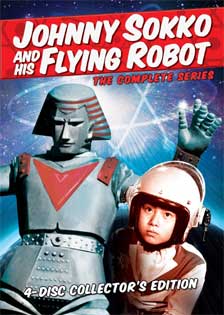 JOHNNY
SOKKO AND HIS FLYING ROBOT (1967-1968)
JOHNNY
SOKKO AND HIS FLYING ROBOT (1967-1968)Shout! Factory
 JOHNNY
SOKKO AND HIS FLYING ROBOT (1967-1968)
JOHNNY
SOKKO AND HIS FLYING ROBOT (1967-1968)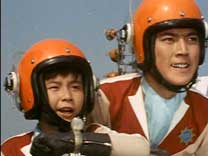
By 1967, the Japanese giant monster boom was really in full swing on an international level. Not only did audiences on both sides of the Pacific enjoy Toho’s seemingly never-ending kaiju (monster) films of that year such as KING KONG ESCAPES and SON OF GODZILLA, but other studios such as Daiei produced GAMERA VS. GYAOS; Nikkatsu released GAPPA, THE TRIPHIBIAN MONSTER while Shochiku chimed in with THE X FROM OUTER SPACE. On television, Tsuburaya Productions produced the popular ULTRA Q and ULTRAMAN series (the latter picked up by United Artists Television and broadcast on American television with dubbing done by the great vocal artists at Titra Sound Studios in New York). In 1967, Manga artist Mitsuteru Yokoyama (who also created 1965’s cartoon series TETSUJIN 28-GO which was Americanized by Fred Ladd under the title GIGANTOR) created a live action science fiction series in the ULTRAMAN flavor about the adventures of a ten year-old Japanese boy and his giant flying robot who performs valiant deeds to protect our earth. Thus, JYAIANTOROBO (GIANT ROBOT) was born and eventually made the journey to the United States courtesy of American International Television (AIP-TV) to syndication on UHF stations in 1969. Now, as part of their recent deal with MGM/Fox to license and release some of their properties, Shout! Factory has released all twenty-six episodes of this wildly absurd, but fondly remembered and totally entertaining cult series in an attractive four DVD set.
 The
basic premise of the series features Earth being invaded by the ugly reptilian-looking
Emperor Guillotine from the planet Gargoyle landing his spaceship in the Pacific
Ocean and causing a variety of marine disasters. While sailing on one of these
ill-fated ships, ten year-old Daisuke Kusama (re-christened “Johnny Sokko”
in the English version) meets Unicorn agent Jiro Minami (“Jerry Mano”
in the English version). Unicorn is a secret organization dedicated to preserving
peace on our planet by fighting off all enemies (human or alien as it turns
out). When the Gargoyle controlled monster Draculon attacks and sinks the ship,
Johnny and Jerry escape only to be shipwrecked on an island under the Gargoyle’s
control. It turns out the aliens are using the lost island as a base to force
Dr. Lucius Guardian (Jack Ongun) to construct a giant robot to carry out their
evil deeds. However, Dr. Guardian plants a nuclear(!) bomb to destroy the base
and kill the Gargoyles. Once the bomb goes off, it turns out that the radiation
from the device is enough to activate the giant robot and with a remote controlled
watch, young Johnny can now control the robot and have it work for the good
of the world through Unicorn.
The
basic premise of the series features Earth being invaded by the ugly reptilian-looking
Emperor Guillotine from the planet Gargoyle landing his spaceship in the Pacific
Ocean and causing a variety of marine disasters. While sailing on one of these
ill-fated ships, ten year-old Daisuke Kusama (re-christened “Johnny Sokko”
in the English version) meets Unicorn agent Jiro Minami (“Jerry Mano”
in the English version). Unicorn is a secret organization dedicated to preserving
peace on our planet by fighting off all enemies (human or alien as it turns
out). When the Gargoyle controlled monster Draculon attacks and sinks the ship,
Johnny and Jerry escape only to be shipwrecked on an island under the Gargoyle’s
control. It turns out the aliens are using the lost island as a base to force
Dr. Lucius Guardian (Jack Ongun) to construct a giant robot to carry out their
evil deeds. However, Dr. Guardian plants a nuclear(!) bomb to destroy the base
and kill the Gargoyles. Once the bomb goes off, it turns out that the radiation
from the device is enough to activate the giant robot and with a remote controlled
watch, young Johnny can now control the robot and have it work for the good
of the world through Unicorn.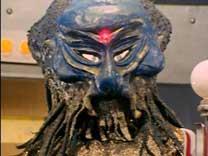
After this initial introduction, the remainder of the series followed a monster-of-the-week formula as Emperor Guillotine would send some dastardly monstrosity to attack Unicorn and it would look like the end of the organization (and of our planet) until the last act when the robot would heroically come to Johnny’s rescue.
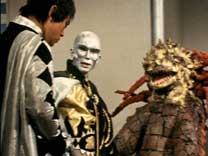 As
noted earlier, AIP-TV handled the American release of the series and in 1970,
they culled together five episodes (with some editing of the episodes) and released
the “movie” VOYAGE INTO SPACE. Many genre fans of this reviewer’s
age group (44) will remember with great fondness watching this film as part
of New York’s "The 4:30 Movie" on WABC-TV. It was often shown
as part of a “monster week” with other AIP-TV films such as DESTROY
ALL PLANETS, ATTACK OF THE MONSTERS, FRANKENSTEIN CONQUERS THE WORLD, DAGORA,
THE SPACE MONSTER and MONSTER FROM A PREHISTORIC PLANET (in any combination
thereof). In addition, many fans may also remember the 8mm digest released by
Ken Films of Fort Lee, New Jersey in the 1970s. One could purchase the film
in a twelve minute black and white and silent version or an eight minute sound
and color digest.
As
noted earlier, AIP-TV handled the American release of the series and in 1970,
they culled together five episodes (with some editing of the episodes) and released
the “movie” VOYAGE INTO SPACE. Many genre fans of this reviewer’s
age group (44) will remember with great fondness watching this film as part
of New York’s "The 4:30 Movie" on WABC-TV. It was often shown
as part of a “monster week” with other AIP-TV films such as DESTROY
ALL PLANETS, ATTACK OF THE MONSTERS, FRANKENSTEIN CONQUERS THE WORLD, DAGORA,
THE SPACE MONSTER and MONSTER FROM A PREHISTORIC PLANET (in any combination
thereof). In addition, many fans may also remember the 8mm digest released by
Ken Films of Fort Lee, New Jersey in the 1970s. One could purchase the film
in a twelve minute black and white and silent version or an eight minute sound
and color digest.
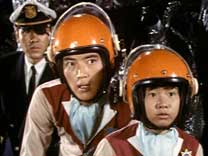
Shout! Factory’s release of the entire series comes approximately two years after MGM was originally scheduled to release the show as part of their MOD (made-on-demand) series of DVDs. After deciding the transfers were not up to snuff, MGM cancelled the release and the future of its ever coming to DVD remained in limbo. Now Shout! Factory has released the entire series on DVD with very nice packaging as well as a 24-page booklet by noted Japanese monster fan/historian August Ragone which features the original Japanese titles, their renamed American titles as well as the production order and airdates of each episode. August also goes into a mammoth description of the creation of the program and its eventual American translation. There is also a reprinted interview with Johnny Sokko himself, the late Mitsunbu Kaneko. The video masters were NOT re-mastered for this release…this reviewer wants to make that 100% clear in case that is a deal breaker for genre DVD collectors. However having said that, other than the opening titles (which look truly awful), the episodes themselves are in very good shape. The show was shot in 16mm and in standard 1.33:1 and has the usual grain and speckles, but colors are excellent and lively and the English ONLY (the Japanese audio is NOT on this release) audio (Dolby Digital) is also quite good. This release is truly better than the God-awful ULTRAMAN collection from another DVD company a couple of years ago. That travesty featured out-of-synch dubbing (more so than usual for a dubbed film) and an English language track that was barely audible in spots, subtitles which did not automatically come on when dialogue sequences turned to Japanese, and some episodes with the song in Japanese and then to English in other episodes…all in all…that was a very sloppy release. This one is miles and miles ahead of that.
Genre fans will truly have a great time with JOHNNY SOKKO AND HIS FLYING ROBOT. It accurately foreshadowed future shows/movies like the Shaw Brothers’ INFRA-MAN (1975) and THE MIGHTY MORPHIN POWER RANGERS of the 1990s. It also represents a time of television innocence and good clean fun that is lacking in many of the dubious “kids” shows of today. (Joe Cascio)